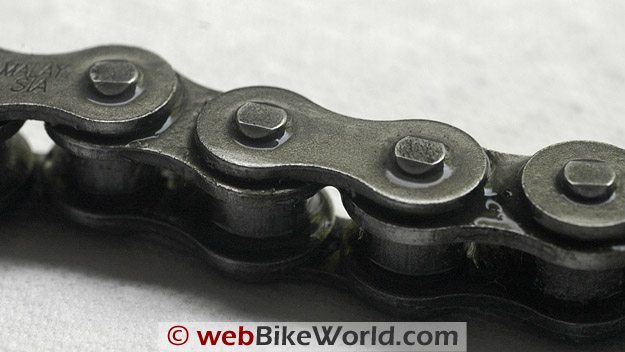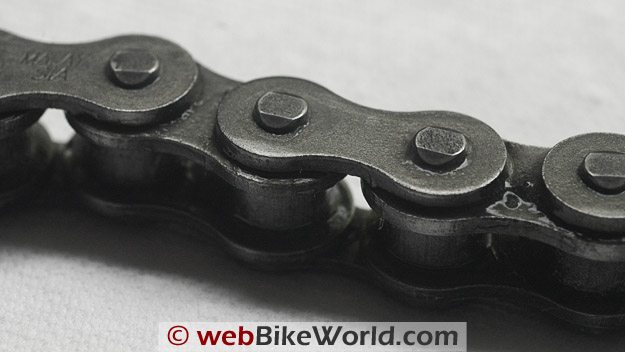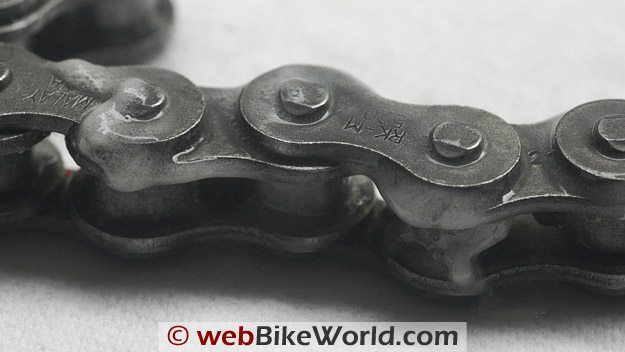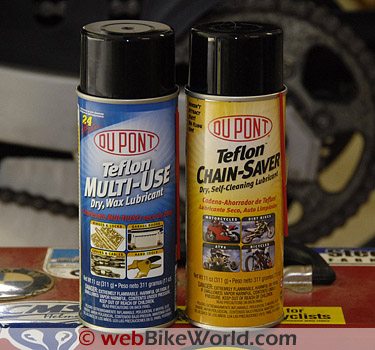DuPont Teflon Chain-Saver Dry, Self-Cleaning Chain Lube
DuPont Teflon Multi-Use chain lube is one of our all-time favorites.
DuPont Teflon Chain-Saver is now commercially available also with a slightly different formulation.
We reviewed DuPont Teflon Multi-Use chain lube back in 2005, and it’s quickly become a favorite with many webBikeWorlders.
There are a few good reasons for this, but number one is that the product is readily available in just about every local hardware store.
It’s also easy to apply; it’s clear and non-sticky, so it doesn’t attract dirt and grit; and it quickly dries to a waxy finish.
About one year ago, a webBikeWorld visitor wrote to ask about another DuPont product he found; DuPont Teflon Chain-Saver Dry, Self-Cleaning Lubricant.
I did a little research (i.e., emailed DuPont) and discovered that Chain-Saver was marketed to industry rather than consumers.
But Chain-Saver has now become readily available in hardware stores in the U.S., and DuPont sent us spray cans of both chain lubes for an update.
The “original” Teflon Multi-Use Dry, Wax Lubricant (the official product name) is the same old product we know and love.
It sprays on clear and dries quickly, leaving a waxy film with Teflon and Molybdenum, two excellent lubricants.
So not a lot of news there — other than the fact that the Multi-Use formula includes moly, a surprise to me.
DuPont told us that the newer Chain-Saver lube also uses the same basic formula as the Multi-Use lubricant, but Chain-Saver contains more of both the Teflon and moly for added temperature and pressure resistance.
DuPont says that both lubes can withstand temperatures up to 300° F (149° C), and both are listed as “O-ring safe”.
Something else we learned is that both products contain calcium stearate. A bit more research taught me that calcium stearate, or [CH3(CH2)16CO2]2Ca, is also a type of lubricant and is the basis for soap.
Used in the DuPont chain lubes, calcium stearate is said to help release dirt, thus the “Self-Cleaning Lubricant” byline on the Chain-Saver product. The Chain-Saver label also says it has a “Patented ‘self-cleaning’ action (that) sheds contaminants…”.
DuPont Teflon Chain Saver
We asked DuPont about the differences between the two products and they indicated that the two lubes are nearly identical.
However, we noticed that Chain-Saver is much thicker and more like a conventional motorcycle chain lube. When sprayed on a chain (after shaking the can per instructions), it leaves a much heavier residue than the Multi-Use spray.
You can see this in the photos and especially in the video below.
Some motorcyclists prefer a heavier formula that looks like it’s sticking to the chain, so no problem there.
However, the Chain-Saver does not completely dry like the Multi-Use chain lube, despite the label’s claim that it “Goes on wet, sets up dry” and “Sets up to a clean, dry, wax film which will not absorb dirt or grime”.
I guess it’s all in how you define the word “dry”! The Chain-Saver label also proclaims that the product “Will not drip or fling off”.
Here’s a close-up photo of a section of chain used for illustration only (we purposely sprayed the side plates rather than between the plates and the links).
The first photo was taken immediately after spraying on the Multi-Use Dry, Wax Lubricant. The “wet” sections are visible:



Where to Buy DuPont Teflon Chain Lube
Check Reviews & Prices on Amazon Check Reviews & Prices On RevZillaSee More: Motorcycle Chain Lube, Motorcycle Accessories, Motorcycle Lubricants
After leaving it to dry for several minutes, the Chain-Saver lube does not look much different, and it still has a “gooey” feel, but it’s not sticky.
The spray can and pressure seems to be about the same for both lubes, so it’s easy to spray on too much Chain-Saver. I spray it on the top side of the bottom run, let it dry for a few minutes and then wipe off any excess.
DuPont says the Chain-Saver lube won’t fling off, and as long as it’s applied with relative care, it does seem to stay in place, but it doesn’t “disappear” like the Multi-Use lube.
Multi-Use vs. Chain Saver
Most chain lubes that we’ve reviewed (and there have been many; see the right-hand column for links to the reviews) have stayed on the chain.
I rarely seem to have a problem with chain lube flinging off the chain and on to the bike, as long as the lube is carefully applied.
But, I’m not very fussy at all when it comes to cleaning the motorcycle, so I probably couldn’t tell whether or not the grime was from lube flinging off the chain or just the normal dirt and grit that comes from riding. I wash the bike about once a year, whether it needs it or not!
Now DuPont also mentioned something that is very interesting about both lubes:
Despite the Chain-Saver label, which claims that the product is a “Self-Cleaning Lubricant”, DuPont told us that the “self-cleaning” characteristics of Multi-Use means that it should be reapplied “every 50 to 75 miles”.
Both products are also available in 4 oz. squeeze bottles, which might be easier to carry on a motorcycle.
But 50 to 75 miles seems very conservative, and since a tank of gas will probably last a couple of hundred miles, I don’t think a motorcyclist will want to stop every 75 miles or so to lubricate the chain.
All I can say is that we’ve been using Multi-Use Dry, Wax Lubricant here for a few years and I spray it on every few hundred miles or so, with good results. Of course, I haven’t scientifically measured chain and sprocket wear, but the spray seems like it does the job.
Tucker Rocky, one of the largest distributors of motorcycle products in the U.S.A., will soon be distributing DuPont Teflon Chain-Saver Dry, Self-Cleaning Lubricant to motorcycle shops everywhere, so it should be even easier to find.
This fact tells me that DuPont thinks it is a good (and comparatively inexpensive) competitor to other brands of motorcycle chain lubes.
It also tells me that DuPont is counting on Chain-Saver to be the “real” chain lube, so the thicker formulation, more Teflon and moly and calcium stearate make sense.
So keep an eye out for it and give it a try and let us know what you think!
Conclusion
I’ve been partial to the old standby, DuPont Teflon Multi-Use Dry, Wax Lubricant, but I like the “gooey-ness” of the new Chain-Saver Dry, Self-Cleaning chain lube.
Both products are easy to find; they’re much cheaper than most of the other brands of motorcycle chain lube, and if Chain-Saver works as good as or better than Multi-Use, I’ll be in chain lube heaven!
UPDATE: Note from DuPont on availability: The products are available at ACE and True Value hardware stores in the U.S.A., if the individual stores decide to carry the product.
Many stores do not carry the products but can easily obtain them upon request. All Lowe’s stores in the U.S.A. should be stocking the products as of June. As of May 2009, 1000 out of 1650 Lowe’s stores carry the products.
UPDATE 2 (10/09) Where to Buy DuPont Chain-Saver: (From DuPont) “Over the past few months, ever since your review of Chain-Saver (was published), all of our DuPont inquiry lines have been inundated with questions about where to get Chain-Saver.
We have been getting at least 50 per week! Your site is VERY influential in the motorcycle community.
Just this moment, I have received a large order from Tucker Rocky for Chain-Saver. That means that any motorcycle shop that they supply, has access to Chain-Saver.
We have also gotten word that Mills Fleet Farm, a chain of stores in the Midwest, will be carrying Chain-Saver on shelf in January. If you could let your members know of this development, that would be very helpful.”
| wBW Review: DuPont Teflon Chain Lube | |
|---|---|
| Manufacturer: DuPont Performance Lubricants | List Price (2009): Chain-Saver – $8.95 for 11 oz. (311 g) can or $3.95 for 4 oz. bottle. Multi-Use – $6.95 for 11 oz. (311 g) can; 4 oz. bottle price unknown. |
| Colors: Clear | Made In: U.S.A. |
| Review Date: May 2009 Notes: Both products also available in bulk sizes including 1.5 lbs., 6 lbs. and 30 lb. tubs. | |
|
Note: Item was provided by a retailer, distributor or manufacturer with these Terms and Conditions.
|
|
Where to Buy DuPont Teflon Chain Lube
Check Reviews & Prices on Amazon Check Reviews & Prices On RevZillaSee More: Motorcycle Chain Lube, Motorcycle Accessories, Motorcycle Lubricants
Owner Comments and Feedback
See details on submitting comments.
From “N.S.”: “I haven’t tried Liquid Performance chain lube (review), but I can attest that converting to DuPont Teflon Chain Saver lube has completely changed how I maintain my chain drive.
On my 2005 FZ1, much like other chain-driven bikes I’ve owned, I had to clean and lube the chain about every 250-350 miles and actually adjust chain tension about every 500-600 miles.
I ride rather aggressively, so this has been the norm for many of my 1990’s and newer bikes between 600-1000cc.
Since I’ve been exclusively using DuPont Teflon Chain Saver lube and DuPont Motorcycle degreaser (review) I’ve now switched to lubing the chain every 350-450 miles and I’m not having to adjust the chain except every 1500-2000 miles.
I’m riding just as aggressively, so I can only assume the cleaner and lube combined are doing a better job of cleaning and reducing friction, so the chain’s stretching less.
I’m certainly not complaining at the added chain life, and the sprockets seem to be just as happy. I only wish motorcycle and general hardware retailers carried it, so I didn’t have to order it via Amazon.”
From “D.M.” (4/10): “Just wanted to clarify M.S.’s comment (first comment at the bottom below). Per the Dupont website, I’d say that while it is a good product (see the Temperature rating) it is NOT the same product as the ChainSaver!
From the DuPont website: Multi-Use Lubricant Info and here is the Teflon Silicon Lubricant.
From “T.E.” (1/10): “Many thanks for that really good article!
In the past, I just put real sticky sprays on, thinking, together with the grease all other road dirt is leaving the chain after 300-400 miles, anyway. Doing so – really without any cleaning procedure – it ended up in a very usual chain live cycle of 15-20.000miles.
A second theory is – my own feeling told me – that a greasy and little more dusty chain is over an only less dusty but dry chain!
Don’t forget the hard beat (3) on each and every chain roll and joint when entering the sprocket without any grease as a damper in between!
Nevertheless I felt poor, after earning only 20.000 miles with this procedure. Another strange thing happened most times to the chain: The O-rings started to disappear on some joints after only 10-15.000 miles!
A change happened, after mounting a golden colored “Regina” chain:
To keep the chain’s look clean and golden, I started to “polish” the chain (more the side plates, less in the middle) with a real harsh cleaning rag or terry cloth towel after each lube applying (still sticky type, because of theory 2 & 3)!
Now, this ended up in a 30.000 miles live cycle (all on a Honda XX, same conditions, nearly only sunshine trips, no winter times).
Today, I’m still practicing this way and very happy about the “dry” and quick cleaning procedure without any wet, greasy “contamination” to be kept and disposed eco-friendly.
By the way, a Austrian motorcycle magazine “Der Reitwagen” once tested a Honda VT 1000 without ANY lubricating AND! cleaning the chain at all, what gave them – for me really unbelievable – a 12k miles live cycle!!!
But, what I’ve heard now from your article makes me really interested in the DuPont product, hoping it will be available here in Germany, too!”
From “T.H.” (1/10): “Just wanted to offer a new motorcycle rider’s input on using the DuPont Teflon Multi-Use spray (blue can).
It was based on your original DuPont Teflon Chain Lube review and the DuPont Teflon Chain Lube Update review that I started out lubing the chain on my brand new ’09 Kawasaki 650R (bought with 1 mile in April ’09) with the Multi-Use spray.
Between then and storing it on November 30, 2009 I amassed just over 2,000 miles on it. I sprayed the chain about every 400 miles (owner’s manual recommended intervals) or after I washed the bike, and I could not be more happy with the results!
As other users have responded in support of the reviews, the lube picks up very little (if any) road dirt or grit. In fact, so little so that most of the lubes I did didn’t need a pre-cleaning.
The spraying of the lube wet on the chain sprayed off any particles that I noticed beforehand. Of course, I intend not for DuPont’s product to put me in the habit of not cleaning the chain when necessary!
In fact, the only problem I had during my first year of chain maintenance was the dealership not following my service request to avoid lubing the chain (I had done it prior to the visit).
And of course, they didn’t pay attention and used some sticky stuff that instantly picked up dirt and grit. It was promptly cleaned and replaced with the DuPont product!
Also, good to hear that Chain Saver will be at Mills Fleet Farm! I am local to those stores and will try out the Chain Saver to compare with the regular Multi-Use when they stock it.”
From “D” (5/09): “Thanks for the excellent review. I don’t know anything about the chemistry of either the lube or the O-rings, but I got 25,366 miles out of my last chain and nearly all those miles were lubricated by DuPont Teflon Multi-Use.
Near as I could tell, all o-rings were still intact and there was none of the tell-tale signs of corrosion.
I replaced the chain because it was worn unevenly; however, it wasn’t excessively worn. I was even able (for the first time ever on any bike) to re-use the sprockets.
Perhaps the grit, grime and small critters that cling to “stickier” lubes causes more wear on the driveline than we realize?
The DuPont Multi-Use product is now the only lube I’ll use for drive chains, and as a bonus you can use it on your cables (and just about anywhere there is metal-to-metal contact) as well, thus replacing at least two products with one.”
From “S.S.” (5/09): “I used the PJ1 Blue Label product as advised by my shop, but the chain was constantly picking up dirt and always looked grimy.
After reading your DuPont review a few months ago, I purchased the DuPont spray at my local Lowe’s, and applied it after cleaning my chain. My chain now looks clean and brand new, and does not pick up any dirt or grime.
I agree with one of the previous respondents who said that dirt and grit probably do as much harm as not enough lube, and the Teflon spray definitely does not pick up dirt.
My sprocket cover is probably much cleaner inside, and I find it a quick and easy job to reapply the Teflon spray every couple of hundred miles. I’ll definitely stay with the lighter product.”
From “D” (5/09): “I have been using a product called Super Lube (synthetic, contains PTFE) on virtually anything that requires lubrication; i.e., firearms, bicycle chain, disc brake calipers, hinges, etc.
So when I recently bought my DR650se I thought I’d use it on the O-ring chain. It comes out of the can thin but after a few minutes it thickens up to a grease. However, I had some concern that it might adversely affect the O-rings.
I called customer service at Super Lube and the lady said that it depends on the material that the O-ring is made of. There is a list of materials that it’s safe for but I haven’t been able to find out exactly what the O-rings are made of. Does anyone have this information?
Great article. Very informative.”
Editor’s Reply: O-rings are usually made from Buna-N synthetic rubber, although each manufacturer may have a specific formula for this, although I bet all the O-rings are probably made at the same factory somewhere!
I’m kind of surprised she said it depends — most chain O-rings must be made from nearly the same stuff, when you think about it, unlike O-rings designed for specific sealing requirements, which can be made from anything from silicone to rubber.
I guess you could buy a regular old O-ring in a hardware store and put it on a plate and spray some lube on it and let it sit for a few days. If it doesn’t dissolve, you’re probably ok!
Perhaps one of our readers has more information on this?
UPDATE: Paul D. from Chain Drain (review) sent us this link to a .pdf spec sheet for nitrile Buna N Acrylonitrile Butadiene O-rings from Robinson Rubber, which are apparently the type used in motorcycle chains.
Looking at the specifications, the material has “Poor” resistance to amines, brake fluids, esters, ethers, halogenated solvents and ketones.
So I’d guess that any type of degreaser, cleaner or solvent with one or more of those compounds would not be recommended for cleaning an O-ring equipped motorcycle chain.
The trick, of course, is knowing whether the cleaning agent actually has one of those ingredients or not, and manufacturers may not want to reveal this information.
From “AD” (5/09): “My experience with “sticky” chain lubes is that they do indeed stick to the chain after they are applied. However, the sticky remainder causes dirt and sand to adhere to the chain.
My feeling is that the presence of this road grime shortens the life of the chain and causes buildup around the sprockets and chain guides. For this reason, I’ll buy the old-style DuPont lube rather than the new sticky kind.
I currently use a Teflon bicycle lube. I’ve also used hypoid gear oil. These can be messier to apply, and I probably need to use them more often than I would use sticky lubes, but my chain and bike stay clean and my chain life is good.
It is my understanding that on o-ring chains, lube is necessary only to keep the rubber o-rings from losing their seal. That much is easily accomplished with non-sticky lubes.
Of course, your motorcycling may vary! ”
From “M.S.” (5/09): “I am a fan of the DuPont Multi-Use Teflon Spray, I have been using it on my bike chains for a while w/ great results.
Today I went to Lowe’s to buy a can of the Multi-Use stuff and found the Chain Saver spray can disguised as “Teflon Silicon Lubricant”.
The can is the same color scheme as the one in your review but with the motorcycle pics replaced w/ a house, a boat, a car and a tread mill. I guess they do this to target different markets. Again thanks for your great reviews.
Blue can $4.98 Other can $3.99 SoCal weather $priceless.”
Other WebBikeWorld Chain Lube Posts




No Comment